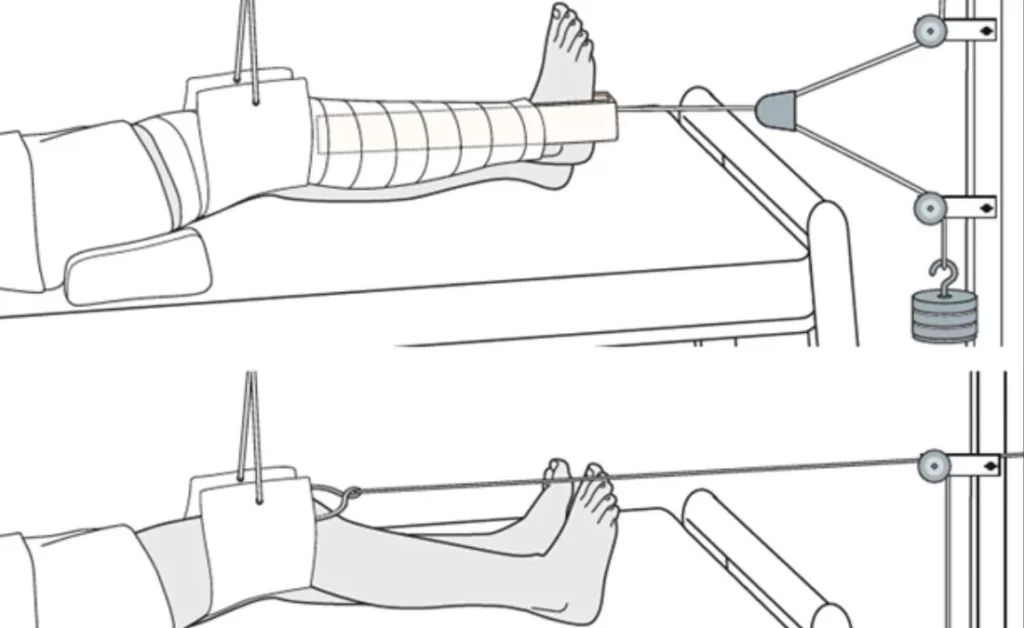Bucks traction is a commonly used orthopedic treatment that plays a pivotal role in immobilizing and stabilizing various orthopedic conditions. The significance of Bucks traction in orthopedics, as well as its history, indications, setup, and patient care, are all discussed in detail in this article.
Orthopedic practitioners often use Bucks traction, a non-invasive technique, to treat dislocations, fractures, and other musculoskeletal injuries and disorders. It was pioneered in the early 20th century by an American surgeon by the name of Charles E. Bucks.
Contents
- What Is Bucks Traction?
- The History of Bucks Traction
- Indications for Bucks Traction
- How Does Bucks Traction Work?
- Types of Bucks Traction
- Setting up Buck’s Traction
- Nursing Care for Patients Undergoing Buck’s Traction
- Buck’s Traction vs. Other Traction Methods
- Potential Complications and Side Effects
- Patient Experience and Comfort
- The Role of Buck’s Traction in Orthopedics
- Advancements in Traction Techniques
- Conclusion
What Is Bucks Traction?
Application of longitudinal force to a broken or injured limb is at the heart of Bucks traction. Its purpose is to temporarily immobilize the affected area, alleviate pain, and stop any further injury.
The History of Bucks Traction
The history of Bucks traction begins in the 1920s, when it was first introduced by Dr. Charles E. Bucks. It has progressed over time to become standard practice in orthopedic medicine.
Indications for Bucks Traction
Fractured femurs, dislocated hips, and certain spinal injuries are common indications for the use of Bucks traction. Its primary objective is to promote healing by stabilizing the injured area.
How Does Bucks Traction Work?
A controlled amount of force is applied to the broken or injured bone, which helps heal the fracture or injury. It helps the body heal by realigning the broken bones, relaxing the tight muscles, and decreasing the amount of pain felt.
Types of Bucks Traction
Bucks traction can be broken down into two categories: cutaneous and skeletal. The orthopedic condition at hand and the patient’s preferences will determine which option is best.
Setting up Buck’s Traction
Buck’s traction requires the application of tape (either adhesive or non-adhesive) to the skin or the insertion of pins into the bone. Effective treatment relies on a well-prepared environment.
Nursing Care for Patients Undergoing Buck’s Traction
Buck’s traction patients need specialized nursing care to keep them comfortable, prevent complications, and keep tabs on their health.
Buck’s Traction vs. Other Traction Methods
Buck’s traction offers benefits in terms of ease of use, efficiency, and patient comfort over alternative traction methods. Because of its usefulness and its simplicity of implementation, it has found widespread use.
Potential Complications and Side Effects
Pressure sores, nerve damage, and circulatory issues are all possible side effects of Buck’s traction, as they are with any medical procedure. To avoid these problems, constant monitoring is required.
Patient Experience and Comfort
It’s common for patients to have concerns about the traction treatment they’ll receive in Bucks. One of the most important aspects of orthopedic care is listening to and calming patient fears and discomfort.
The Role of Buck’s Traction in Orthopedics
Buck’s traction is an essential method used to aid in the rehabilitation of patients suffering from musculoskeletal injuries.
Advancements in Traction Techniques
While the basic principles of Buck’s traction remain the same, advancements in technology and materials have improved patient comfort and outcomes over the years.
Conclusion
For many musculoskeletal issues, Buck’s traction is an effective and non-invasive treatment option, making it an essential tool in orthopedics.
FAQs
1. Is Buck’s traction painful?
Contrary to popular belief, Buck’s traction is not intended to treat or cure orthopedic conditions.
2. How long does a patient typically stay in Buck’s traction?
Buck’s traction is typically used as a stopgap measure until the cause of the problem is identified and a more permanent solution is found.
3. Can Buck’s traction be used for children?
Yes, Buck’s traction is suitable for both adults and children, with adjustments made for paediatric patients.
4. Are there any restrictions on movement during Buck’s traction?
Patients undergoing Buck’s traction are required to remain immobile to maximize the treatment’s efficacy.
5. What is the success rate of Buck’s traction in treating orthopedic conditions?
Buck’s traction is a reliable method for treating orthopedic injuries and conditions, with a high rate of success.











